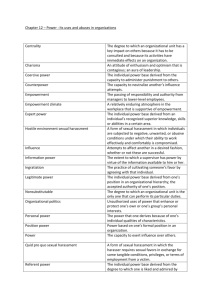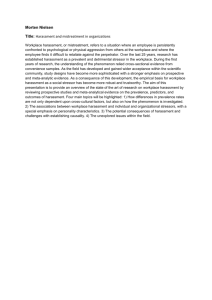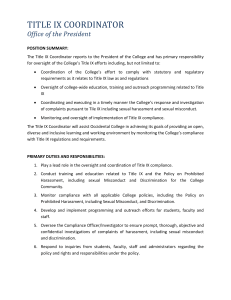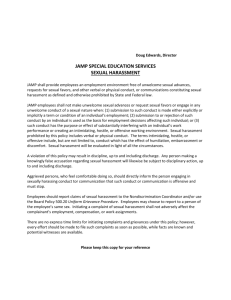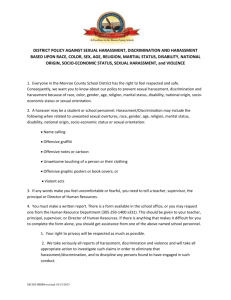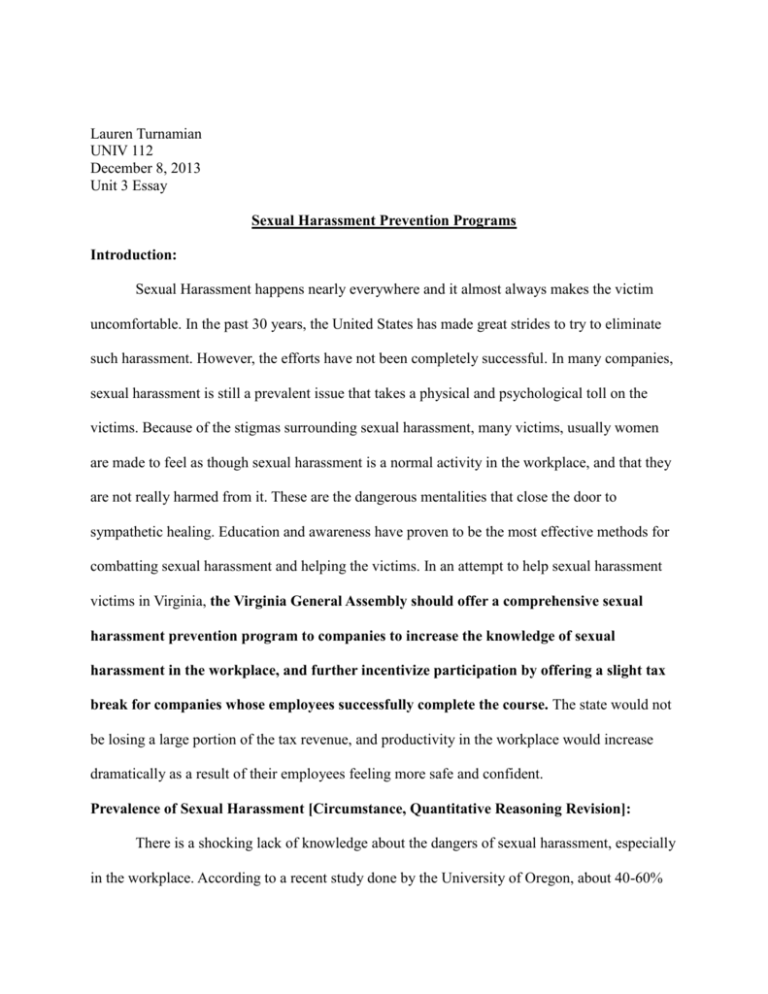
Lauren Turnamian
UNIV 112
December 8, 2013
Unit 3 Essay
Sexual Harassment Prevention Programs
Introduction:
Sexual Harassment happens nearly everywhere and it almost always makes the victim
uncomfortable. In the past 30 years, the United States has made great strides to try to eliminate
such harassment. However, the efforts have not been completely successful. In many companies,
sexual harassment is still a prevalent issue that takes a physical and psychological toll on the
victims. Because of the stigmas surrounding sexual harassment, many victims, usually women
are made to feel as though sexual harassment is a normal activity in the workplace, and that they
are not really harmed from it. These are the dangerous mentalities that close the door to
sympathetic healing. Education and awareness have proven to be the most effective methods for
combatting sexual harassment and helping the victims. In an attempt to help sexual harassment
victims in Virginia, the Virginia General Assembly should offer a comprehensive sexual
harassment prevention program to companies to increase the knowledge of sexual
harassment in the workplace, and further incentivize participation by offering a slight tax
break for companies whose employees successfully complete the course. The state would not
be losing a large portion of the tax revenue, and productivity in the workplace would increase
dramatically as a result of their employees feeling more safe and confident.
Prevalence of Sexual Harassment [Circumstance, Quantitative Reasoning Revision]:
There is a shocking lack of knowledge about the dangers of sexual harassment, especially
in the workplace. According to a recent study done by the University of Oregon, about 40-60%
of working women experience sexual harassment at least once in their lifetime (Oregon). Though
this is not to say that every occurrence is in the workplace, it is important to see the larger scope
of sexual harassment. Roughly 31% of women in the workplace have experienced sexual
harassment at least once (EEOC).Ultimately, the goal is to ensure everyone in the company,
especially those in leadership positions, are knowledgeable enough and engaged enough in the
company to prevent sexual harassment before it even occurs (MacKinnon 58). This same study
showed that ignoring the harassment does not make it disappear. In fact, the researchers claim
that it is actually agreeing with and encouraging the behavior, not punishing it. Though some
claim that women just make up instances of harassment in the workplace, researchers found that
less than one percent of all complaints have no real backing. It is actually more common for a
victim to remain silent than a person file a false complaint; only 12% of all sexual harassment
victims actually report the crimes (Oregon). The only way to totally stop sexual harassment now
and prevent it in the future is through education. It was estimated that in 2011, $52.3 million in
damages were awarded from sexual harassment cases filed through the EEOC. However,
education comes at a much lower cost. The Association of Title IX Administrators, which makes
and distributes Title IX training packages, much like the ones used at VCU, for less than $1,000
(ATIXA). These materials would allow the employer to educate himself and his employees on
many aspects of sexual harassment and the protections against it. With this knowledge, they
would be able to feel more sympathetic toward victims, and the victims would feel safer in their
work environment. With such a widespread issue as sexual harassment, one would think there
would be a large support system in place already. However, the lack of knowledge and false
sense of loyalty to the company, make sexual harassment hard to identify and even harder
to eliminate.
False Loyalty [Consequence]:
Because of the general lack of knowledge of the effects of sexual harassment, it is nearly
impossible to be sympathetic toward the victim. Without a solution, the issue will continue to go
extremely under-noticed and unprevented, thus allowing and even increasing sexual harassment
in the workplace. The real issue lies when companies lack the knowledge of what sexual
harassment really is and what they can do within the company to stop it. This makes it hard to
even identify and nearly impossible to prevent. As a result of this lack of knowledge and
understanding, many women do not feel validated in their attempts to bring about a claim against
the harasser or the company. The victims often get pushed into having a sense of company
loyalty, meaning that they do not want to bring their case to light in fear of giving their
employer’s company a bad name. In large companies, many lower-tier employees adopt the
mindset that they are just tiny parts in a large machine and that their feelings of fear and
uneasiness have no place in their work life, so they do not pursue the cases. Stephanie Strom, a
well-known journalist for The New York Times, has written several articles as a business
correspondent. In one article she outlines yet another aspect of the issue. “Some companies train
and educate only their top managers, rather than the entire work forces,” which really does not
put a dent into solving this problem. The top managers of a company are most likely not
involved in the day-to-day lives of the employees where the harassment occurs. Because of the
ever-growing and damaging consequences to the victim’s health, the Virginia Department
of Health has recently taken a special interest in sexual harassment prevention.
Virginia Department of Health [Authority]:
In 2004, the Virginia Department of Health along with The Virginia Domestic and Sexual
Assault Action Alliance, Virginia’s top advocate for safe sexuality and harassment prevention,
conducted a study to collect “data on the prevalence of sexual assault and characteristics of
victims and perpetrators” (VDH 5). The results of this study showed that incidences of sexual
harassment, especially in the workplace are severely underreported. Their study called for
several efforts of collaboration to increase awareness of sexual harassment everywhere,
including in the workplace. Most importantly, the study called on the Virginia General Assembly
and the Virginia Department of Health to “work with professional organizations such as the
Virginia Hospital and Healthcare Association (VHHA), the Virginia Nurses Association, and the
Medical Society of Virginia (MSV) to raise awareness of sexual assault as a health care crisis”
(VDH 52). Later in the year, the General Assembly passed Senate Joint Resolution 131 which
pushed to enforce prevention programs and stricter law enforcement on cases of sexual
harassment, including in the workplace. It was also extremely impactful because it drew light to
the fact that the uprising of sexual harassment, especially in the workplace is becoming a
healthcare crisis, both physically and psychologically. Though Virginia has made great
legislative strides in combatting sexual harassment in the workplace, only a couple of largescale companies have actualized the goals of education. AT&T is one company that has
worked to develop prevention and awareness policies that are setting the example for more
companies to follow.
Successful Prevention Program [Comparison]:
Though there is still great room for improvement, a few companies have enacted clear
policies to increase awareness and erase stigmas of sexual harassment. For example, AT&T, a
successful wireless cell phone company, has enacted comprehensive sexual harassment
prevention programs that have changed the entire mentality of their workers. Their programs are
eliminating stigmas that opened the door for sexual harassment to occur in their workplace.
Many times, when sexual harassment cases are brought up within a traditional company, it is
seen from the harasser’s perspective, rather than the victim’s, so it lowers the chance of
sympathy toward the victim. At AT&T, the main focus is to eliminate the idea that discrimination
is normal and is to be widely accepted. At the inception of the program, the idea was to eliminate
stigmas toward all forms of discrimination, starting with small interpersonal interactions to
interactions within the company as a whole (January 3). Part of AT&T’s no tolerance policy
includes the idea that some specific actions of a harasser can make the victim feel belittled and
like they have a degraded sense of dignity and integrity. The company’s aim is to increase
awareness of these adverse effects on the wider spectrum of discrimination to encourage its
employees to be more sympathetic and understanding that even minor comments may be hurtful
and even offensive (January 3). The Virginia General Assembly should use AT&T’s
discrimination and harassment prevention programs as examples of how effective polies can
change the whole workplace environment. AT&T has been so successful in slowing the rate of
sexual harassment in their work environment because they have realized that it goes
beneath the surface of physical abuse and is a matter of equality. However, some opponents
of Title IX are not so convinced that gender equality is the matter at stake.
Sexual Harassment as a Healthcare Crisis [Definition, Argumentative Fairness Revision]:
According to the Merriam-Webster Dictionary, sexual harassment can be defined as
“uninvited and unwelcome verbal or physical behavior of a sexual nature, especially by a person
by a person in authority toward a subordinate.” This authority-subordinate relationship may
manifest itself in an employer-employee relationship in the workplace (Merriam-Webster). Some
of the types of sexual harassment in the workplace can be inappropriate comments, touching, or
pressure to perform sexual acts in order to advance in the workplace. Because sexual harassment
is so widely accepted as normal, it is almost impossible for a woman to gain the courage to
report it, which can lead to even more damaging psychological effects as she feels guilty and
responsible even though she is the victim. As Catherine MacKinnon puts it, “working women
have been subject to the social failure to recognize sexual harassment as an abuse at all…it has
been acceptable for men to do, taboo for women to confront” (1). As stated by the Virginia
Department of Health, sexual harassment, especially in the workplace has become a healthcare
crisis. This is for several reasons. First, sexual harassment has been so normalized that it is
rapidly spreading. Second, it is widely underreported. Third, and most importantly, the damaging
effects of sexual harassment go far beneath the surface. Victims are left with deep emotional and
psychological scars from prolonged fear, guilt, and shame (MacKinnon 4). However, some
people would like to disagree. Jeremy Graff, who opposes Title IX, argues that the law is
outdated and puts men at a disadvantage now. He believes, like many other opponents of Title
IX, that in sports especially, the law has gone too far; that now “radical feminists” are taking
over and pushing men out of their positions in sports teams. However, Title IX calls for the equal
chance for both genders to play and for proportional resources to do so. The law is not saying
that men should have to give up their spots on sports teams so that women can play on a men’s
baseball team. The law is advocating the chance to play. It is advocating that no one should be
denied the chance to play based on a characteristic that is virtually unchangeable. Though Title
IX is most commonly applied to collegiate level sports, it is not exclusively so. The same idea
applies that women, or anyone for that matter, should not face discrimination based solely on the
face that she is a woman, or he is not white, or she is from the Dominican Republic. Whether or
not one agrees with Title IX, it is hard to refute the idea that sexual harassment exists, is
psychologically damaging, and taints the victim’s self-image. Since sexual harassment is an
issue that affects society as a whole, it is necessary that the solution come from society as a
whole.
Accountability in the Workplace [Value, Ethical Reasoning Revision]:
The abuses suffered by women in the workplace have had a negative effect on the ways in
which professional women are viewed. Therefore, it is the employers’ responsibility to remain
accountable for the environment within the workplace. It is our responsibility as a whole
community to educate ourselves about the dangers of sexual harassment in the workplace to
increase advocacy and bravery for victims.
Catherine MacKinnon, a Yale University educated lawyer and active feminist, noted that
sexual harassment has developed into a wide spread and complex social issue, so to change it, we
must change society (2). It is not enough to simply change rules and policies in hopes of
eliminating sexual harassment in the workplace; a solution needs to be on a deeper level. As
employers and supervisors become more aware of and accountable for the work environment, the
whole company environment will change. Ultimately, it will make the workplace safer. When the
employees, especially women, feel safe at work, their health and the quality of their work will
improve dramatically.
Accountability in the workplace would be seeing leaders swallow their pride to address
the issues at hand; rather than simply ignoring them or lessening them because they do not want
to admit that there are flaws in the company. Accountability also means establishing trust and
openness within the company. If a victim feels as though she cannot trust her employer, it is
unlikely that she will step up to reveal the harassment. These accountable leaders should also feel
comfortable enough to ask for help from outside the company if need be. According to the
EEOC, interventions from within the company are often biased and lead to false judgments.
Conclusion:
Whether sexual harassment is an issue of gender equality or not, it is a part of our society
that is damaging and needs to be changed. It disrupts the productive atmosphere of the
workplace, allows for negative stigmas to form, and most importantly, psychologically harms the
victims. Some companies have already created and enforced policies to change the negative
mentality around sexual harassment, but it is not enough. A uniform and powerful awareness and
prevention program, much like the one used at VCU is the most efficient and effective way to
combat sexual harassment, not just in the workplace, but in every corner of modern society. By
focusing on education and awareness, the Virginia General Assembly partnered with the
Department of Health can create a comprehensive program that changes the entire dynamic safe
workplace interactions.
Bibliography
“Charge Statistics FY 1997 Through FY 2013.” Charge Statistics. N.p., n.d. Web. 04 Dec. 2014.
Department of Health. “Response to and Prevention of Sexual Assault in the Commonwealth of
Virginia.” Leg2.state.va.us. N.p. 2005. Web. 06 Dec. 2014.
Graff, Jeremy. “Title IX: The Good, the Bad, the Ugly.” Writing.colostate.edu. Colorado State
University, n.d. Web. 05. Dec. 2014.
January, 2014. AT&T’s Code of Business Conduct (n.d): n. pg. Web. 13 Nov. 2014.
MacKinnon, Catherine A. Sexual Harassment of Working Women: A Case of Sex Discrimination. New
Haven: Yale UP, 1979. Print.
“Sexual Harassment.” Merriam-Webster. Merriam-Webster, n.d. Web. 16 Nov. 2014.
“Sexual Harassment: Myths and Realities.” Sexual Harassment Myths. University of Oregon, n.d. Web.
04. Dec. 2014.
Strom, Stephanie. "Harassment Cases Can Go Unnoticed." The New York Times 20 Oct. 1991: n. p. Web.
14 Nov. 2014.
“Title IX Membership: ATIXA: Association of Title IX Administrators” N.p, n.d. Web. 04 Dec. 2014.




